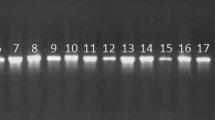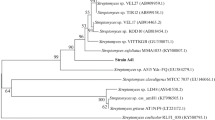Abstract
Endophytic actinomycetes were isolated from six medicinal herbs viz., Abrus precatorius L., Aloe vera (L.) Burm. f., Asparagus racemoses Willd., Adhatoda vasica Nees, Catharanthus roseus (L.) G. Don. and Plumbago zeylanica L. which are known for their ethno botanical properties. A total of 34 endophytic actinomycetes were isolated through surface sterilization procedures. In the present study, procedure I for sterilization was effective for isolation of endophytic actinomycetes. All the medicinal herbs were positive for the endophytic actinomycetes. Maximum number of isolates of endophytic actinomycetes were obtained from Aloe vera (L.) Burm. f. The isolates obtained from roots (55.88 %) dominated over leaf (32.35 %) and stem (11.76 %). All these isolates were assessed for their antibacterial activity against human pathogenic bacteria. Thirteen actinobacterial isolates exhibited antagonistic activity through cross streak assay. The isolates, Streptomyces chromofuscus (Ck-S3) from stem and Streptomyces anulatus (Ck-L2) from leaf portion of Plumbago zeylanica L., showed significant antagonistic activity against all the tested human pathogenic bacteria. Out of 13 isolates, six (46.15 %) isolates obtained from root portion of Aloe vera (L.) Burm. f. and Abrus precatorius L. exhibited antibacterial activity against at least one of the tested pathogenic bacteria in agar well diffusion method.



Similar content being viewed by others
References
Velho-Pereira S, Kamat NM (2013) Actinobacteriological research in India. Int J Exp Biol 51:573–596
Sharma D, Kaur T, Chadha BS, Manhas RK (2011) Antimicrobial activity of actinomycetes against multidrug resistant Staphylococcus aureus, E. coli and various other pathogens. Trop J Pharm Res 10:801–808
Hallmann J, Quadt-Hallmann A, Mahaffee WF, Kloepper JW (1997) Bacterial endophytes in agricultural crops. Can J Microbiol 43:895–914
Zhang HW, Song YC, Tan RX (2006) Biology and chemistry of endophytes. Nat Prod Rep 23:753–771
Benhizia Y, Benhizia H, Benguedouar A, Muresu R, Giacomini A, Squartini A (2004) Gamma proteobacteria can modulate legumes of the genus Hedysarum. Syst Appl Microbiol 27:462–468
Toofanee SB, Dulymamode R (2002) Fungal endophytes associated with Cordemoya integrifolia. Fungal Divers 11:169–175
Castillo UF, Browne L, Strobel GA, Hess WM, Ezra S, Pacheco G, Ezra D (2007) Biologically active endophytic Streptomycetes from Nathofagus spp. and other plants in patogonia. Microb Ecol 53:12–19
Taechowisan T, Chanaphat S, Ruensamran W, Phutdhawong WS (2014) Antibacterial activity of new flavonoids from Streptomyces sp. BT01; an endophyte in Boesenbergia rotunda (L.) Mansf. J Appl Pharm Sci 4:008–013
Germaine K, Keogh E, Cabellos G, Borremans B, Van der Lelie D, Barac T, Oegen L, Vangronsveld J, Porteous Moore F, Moore RB, Campbell CD, Ryan D, Dowling DN (2004) Colonization of polar trees by gfp expressing bacterial endophytes. FEMS Microbiol Ecol 48:109–118
Shweta S, Gurumurthy BR, Ravikanth G, Ramanan US, Shivanna MB (2013) Endophytic fungi from Miquelia dentate Bedd. Produce the anti-cancer alkaloid, camptothecine. Phytomedicine 20:337–342
Ren Z, Zhang XY, Zhu K, Feng DS, Wang YD (2007) Screening and identification of diosgenin-producing endophytic bacteria from Paris polyphylla chinensis. J Microbiol 27:6–9
Shirling EB, Gottlieb D (1966) Methods for characterization of Streptomyces species. Int J Syst Bacteriol 16:313–340
Kenneth LK, Deane BJ (1955) Colour universal language and dictionary of names. United States Department of Commerce, National Bureau of Standards, Washington
Kawato M, Shinobu R (1959) Cover slip culture of Streptomyces herbaricolour nov. sp. Supplement: a simple technique for the microscopical observation. Mem Osaka Univ Lib Arts Educ 8:114–119
Holt JG, Kreig NG, Sneath PHA, Staley JT, Williams ST (1994) Bergey’s manual of determinative bacteriology, 9th edn. Williams & Wilkins, London
Langham CD, Williams ST, Sneath PHA, Martimer AM (1989) New probability matrices for identification of Streptomyces. J Gen Microbiol 135:121–133
Balagurunathan R, Subramanian A (1993) Studies on marine Streptomyces nigrifaciens taxonomy and standardization of antibiotic production. Cienc Mar 19:435–443
Winter J, Ilbert M, Graf PC, Ozcelik D, Jkob U (2008) Bleach activates a redox regulated chaporone by oxidative protein unfolding. Cell 135:691–701
Qin S, Li J, Chen HH, Zhao GZ, Zhu WY, Jiang CL, Xu LH, Li WJ (2009) Isolation, diversity and antimicrobial activity of rare actinobacteria from medicinal plants of tropical rain forests in xishuangbanna, China. Appl Environ Microbiol 75:6176–6186
Dudeja SS, Narula N, Anand RC (2009) Plant microbe interactions—a practical manual for laboratory studies. CCS Haryana Agricultural University, Hisar, pp 1–140
Tian XL, Cao LX, Tan HM, Zeng QG, Jia YY, Han WQ, Zhou SN (2004) Study on the communities of endophytic fungi and endophytic actinomycetes from rice and their antipathogenic activities invitro. World J Microbiol Biotechnol 20:303–309
Sardi P, Saracchi M, Ouaroni S, Petrolini B, Borgonovoli GE, Merli S (1992) Isolation of endophytic Streptomycetes from surface sterilized roots. Appl Environ Microbiol 58:2691–2693
Zin NM, Loi CS, Sarmin NM, Rosli AN (2010) Cultivation dependent characterization of endophytic actinomycetes. Res J Microbiol 5:717–724
Paulus B, Kanowski J, Gadek P, Hyde KD (2006) Diversity and distribution of saprobic microfungi in leaf litter of an Australian tropical rainforest. Mycol Res 110:1441–1454
Oliveira MF, Silva MG, Sand ST (2010) Anti phytopathogen potential of endophytic actinobacteria isolated from tomato plants (Lycopersicon esculentum) in southern Brazil and characterization of Streptomyces sp. R18 (6), a potential biocontrol agent. Res Microbiol 161:562–572
Verma VC, Surendra KG, Anuj K, Ashish M, Ravindra NK, Alan CG (2009) Endophytic actinomycetes from Azadirachta indica A. Juss: isolation, diversity and antimicrobial activity. Microb Ecol 57:749–756
Cao L, Qiu Z, You J, Tan H, Zhou S (2004) Isolation and characterization of endophytic streptomyces strains from surface sterilized tomato (Lycopersicon esculentum) roots. Lett Appl Microbiol 39:425–430
Gangwar M, Dogra S, Gupta UP, Kharwar RN (2014) Diversity and biopotential of endophytic actinomycetes from three medicinal plants in India. Afr J Microbiol 8:184–191
Anderson AS, Wellington EMH (2001) The taxonomy of Streptomyces and related genera. Int J Syst Evol Microbiol 51:797–814
Fguira L, Fotso S, Ben Ameur- Mehdi R, Mellouli L, Laatsch H (2005) Purification and structure elucidation of antifungal and antibacterial activities of newly isolated Streptomyces sp. strain US80. Res Microbiol 156:341–347
Fisher PJ, Petrini O, Lappin-Scott HM (1992) The distribution of some fungal and bacterial endophytes in maize (Zea mays L.). New Phytol 122:299–305
Yu J, Liu X, Sun J, Yan X, Qi Fan S (2008) Effect of liquid culture requirements on antifungal antibiotic production by S.rimosus MY02. Bioresour Technol 99:2087–2091
Pillay VK, Nowak J (1997) Inoculum density, temperature and genotype effects on in vitro growth promotion and endophytic colonization of tomato (Lycopersicon esculentum L.) seedling inoculated with a Pseudomonas bacterium. Can J Microbiol 43:354–361
Birber B, Nuske J, Ritzau M, Grafe U (1998) Alnumycin, a new naphthoquinone antibiotic produced by an endophytic Streptomyces sp. J Antibiot 51:381–382
Pandey D, Gupta AK (2014) Antimicrobial activity and phytochemical analysis of Urgenia indica from Bastar district of Chhattisgarh. Int J Pharm Sci Rev Res 26:273–281
Nokaido H, Vaara M (1985) Molecular basis of bacterial outer membrane permeability. Microbiol Rev 49:1–32
Acknowledgments
Authors are thankful to the authorities of Pandit Ravishankar Shukla University, Raipur, Chhattisgarh for providing the necessary facilities for the research. One of the authors (SC) is grateful to UGC for financial support in the form of BSR, JRF (SC). Financial support from DST under FIST program and UGC for DRS-SAP II are gratefully acknowledged. The authors also thank Microbial Type Culture Collection and Gene Bank (MTCC), Chandigarh for providing cultures and Pandit Jawaharlal Nehru Medical College, Raipur, Chhattisgarh, for providing clinical cultures for research.
Author information
Authors and Affiliations
Corresponding author
Ethics declarations
Conflict of interest
The authors declare that they have no conflict of interest.
Rights and permissions
About this article
Cite this article
Chandrakar, S., Gupta, A.K. Antibiotic Potential of Endophytic Actinomycetes of Medicinal Herbs Against Human Pathogenic Bacteria. Proc. Natl. Acad. Sci., India, Sect. B Biol. Sci. 87, 905–915 (2017). https://doi.org/10.1007/s40011-015-0668-9
Received:
Revised:
Accepted:
Published:
Issue Date:
DOI: https://doi.org/10.1007/s40011-015-0668-9




